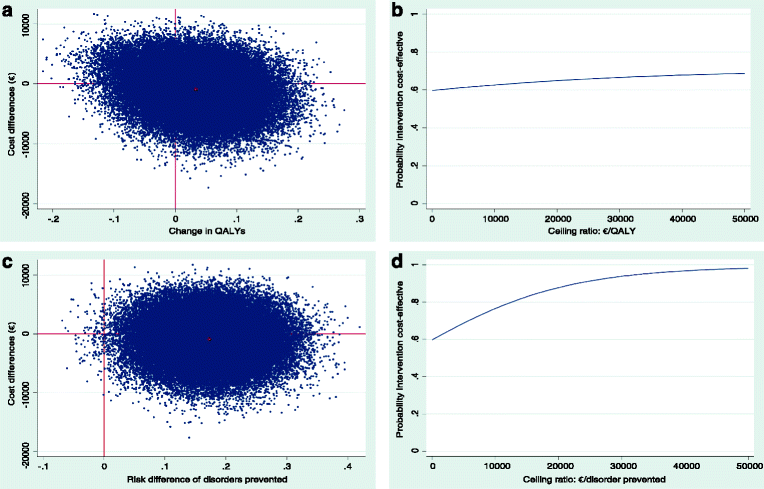Economic evaluation of stepped-care versus usual care for depression and anxiety in older adults with vision impairment: randomized controlled trial
- PMID: 28764679
- PMCID: PMC5539614
- DOI: 10.1186/s12888-017-1437-5
Economic evaluation of stepped-care versus usual care for depression and anxiety in older adults with vision impairment: randomized controlled trial
Abstract
Background: A stepped-care program was found effective in preventing depressive and anxiety disorders in older adults with vision impairment. However, before a decision can be made about implementation, the cost-effectiveness of this program should be investigated. Therefore, we aimed to compare the cost-effectiveness of stepped-care versus usual care within low vision rehabilitation.
Methods: An economic evaluation from a societal perspective was performed alongside a multicenter randomized controlled trial. Data were collected by masked assessors during 24 months. Included were 265 older adults with vision impairment and subthreshold depression and/or anxiety. They were randomly assigned to stepped-care plus usual care (n = 131) or usual care alone (n = 134). Stepped-care comprised 1) watchful waiting, 2) guided self-help based on cognitive behavioral therapy, 3) problem solving treatment, and 4) referral to a general practitioner. Costs were based on direct healthcare costs and indirect non-healthcare costs. Main outcome measures were quality-adjusted life years (QALYs) and the cumulative incidence of major depressive, dysthymic and/or anxiety disorders. Secondary outcomes were symptoms of depression and anxiety.
Results: Based on intention-to-treat, significant differences were found in the incidence of depressive/anxiety disorders (mean difference 0.17; 95% CI 0.06 to 0.29) and symptoms of anxiety (mean difference 1.43, 95% CI 0.10 to 2.77) in favor of stepped-care versus usual care; no significant difference was found for QALYs and symptoms of depression. Societal costs were non-significantly lower in the stepped-care group compared with the usual care group (mean difference: -€877; 95% confidence interval (CI): -8039 to 5489). Cost-effectiveness acceptability curves showed that the probability of cost-effectiveness was 95% or more at a willingness-to-pay of €33,000 per disorder prevented. The probability that stepped-care was cost-effective compared to usual care was 59% or more for a ceiling ratio of 0 €/QALY and increased to 65% at 20000 €/QALY.
Conclusions: This economic evaluation shows that stepped-care is dominant to usual care, with a probability of around 60%, due to its clinical superiority and its modest cost savings. However, it depends on the willingness-to-pay of decision makers whether or not stepped-care is considered cost-effective compared with usual care.
Trial registration: identifier: NTR3296 , date: 13-02-2012.
Keywords: Anxiety; Cost-effectiveness; Cost-utility; Depression; Economic evaluation; Stepped-care; Vision impairment.
Conflict of interest statement
Ethics approval and consent to participate
The study was conducted according to the principles of the Declaration of Helsinki, and approved by the Medical Ethics Committee of the University Hospital Leuven and the VU University Medical Centre Amsterdam. All participants provided written informed consent after explanation of the nature and possible consequences of the study.
Consent for publication
Not applicable.
Competing interests
The authors declare that they have no competing interests.
Publisher’s Note
Springer Nature remains neutral with regard to jurisdictional claims in published maps and institutional affiliations.
Figures

References
Publication types
MeSH terms
LinkOut - more resources
Full Text Sources
Other Literature Sources
Medical

